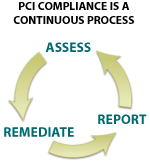The 20th century U.S. criminal Willie Sutton was said to rob banks because “that’s where the money is.” The same motivation in our digital age makes merchants the new target for financial fraud. Occasionally, lax security by some merchants enables criminals to easily steal and use financial information from payment card transactions and processing systems. It’s a serious problem – more than 234 million records with sensitive information have been breached since January 2005, according to Privacy Rights Clearinghouse.org. As a merchant, you are at the center of payment card transactions so it is imperative that you use standard security procedures and technologies to thwart theft of cardholder data.
The payments industry, primarily Visa and MasterCard, implemented the Payment Card Industry – Data Security Standard (PCI-DSS) to combat this fraud. PCI-DSS are 12 technical and operational requirements set by the PCI Security Standards Council (PCI SSC) to protect cardholder data. The Council is responsible for managing the security standards, while compliance with the PCI Security Standards is enforced by the payment card brands. The standards apply to all organizations that store, process or transmit cardholder data – with guidance for software developers and manufacturers of applications and devices used in those transactions.
Merchant-based vulnerabilities may appear almost anywhere in the card-processing ecosystem including point-of-sale devices; personal computers or servers; wireless hotspots or Web shopping applications; in paper-based storage systems; and unsecured transmission of cardholder data to service providers. Vulnerabilities may even extend to systems operated by service providers and acquirers, which are the financial institutions that initiate and maintain the relationships with merchants that accept payment cards.
If you are a merchant that accepts payment cards, you are required to be compliant with the PCI Data Security Standard. You can find out your exact compliance requirements only from your payment brand or acquirer.
3 Steps to the PCI DSS
The PCI DSS follows common-sense steps that mirror security best practices. There are three steps for adhering to the PCI DSS – which is not a single event, but a continuous, ongoing process.
First, Assess: Identify cardholder data, take an inventory of your IT assets and business processes for payment card processing, and analyze them for vulnerabilities that could expose cardholder data.
Second, Remediate: Fix vulnerabilities and do not store cardholder data unless you need it.
Third, Report: Compile and submit required remediation validation records (if applicable), and submit compliance reports to the acquiring bank and card brands you do business with.
If you are a merchant that accepts payment cards, you are required to be compliant with the PCI Data Security Standard. You can find out your exact compliance requirements only from your payment brand or acquirer. Additional information can also be obtained by visiting the PCI Security Standards website at www.pcisecuritystandards.org.
- PCI Security Standards Council


